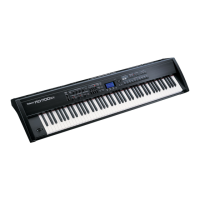24
Jan. 2005 RD-700SX
7. MIDI Check
Confirm the functioning of the MIDI and USB connectors.
fig.13-08test08.eps
First, connect the RD’s “MIDI IN” and “MIDI OUT1” connectors.
fig.13-09test09.eps
If the connection is confirmed as operating correctly, a prompt to
disconnect the MIDI cable appears in the screen; disconnect the cable
from MIDI OUT 1.
fig.13-10test10.eps
A prompt to connect the cable to MIDI OUT2 appears in the screen;
connect the cable to MIDI OUT 2.
fig.13-11test11.eps
If the connection is confirmed as operating correctly, a prompt to
disconnect the MIDI cable appears in the screen; disconnect the MIDI
cable.
fig.13-12test12.eps
A prompt to connect the USB cable appears in the screen; connect the RD
to the PC.
fig.13-13test13.eps
If the USB connection is successful, a prompt to disconnect the USB cable
appears in the screen.
As USB MIDI data is being transferred from the RD at this time, proper
transfer of the data can be confirmed by playing it through the PC’s
internal sound generator.
After connecting the USB cable, start up the PC’s software synthesizer
(e.g., VMT) and play back the music through the PC’s speakers to
confirm there is no problem.
8. Sound Check
A check of the sound module, effects, and audio waveforms is
performed.
fig.13-14test14.eps
Upon entering the test, the [PIANO:0], [E.PIANO:1], [CLAV/
MALLET:2], and [ORGAN:3] LEDs begin to flash.
As each switch is pressed, it is indicated in the display and a test sound is
played.
When the test is completed, all of the LEDs go off.
0:Reverb
Confirm that a piano sound with reverb is played.
1: Lch Sin wave
Confirm that the audio output consists of a sine wave output only from
the left channel.
2: Rch Square Wave
Confirm that the audio output consists of a square wave output only
from the right channel.
3:L+Rch Sin Wave
Confirm that the audio output consists of a sine wave output from both
the left and right channels.
After all test patterns have been displayed, press [→] to advance to the
next test.
9. Device Check
The results of the check for the devices started up in Test 1 are displayed.
fig.13-19test15.eps
If any error is detected, an “NG” (“No Good” i.e., failure) mark is
indicated for the corresponding device.
Only if all tests are passed, the [→] switch may be pressed to advance to
the next test.
If “NG” is indicated for any device, force the procedure to the next
category by pressing [EDIT] + [←]/[→].
10. Factory Reset
This procedure resets the RD in its initialized format.
fig.13-20test16.eps
The [ENTER] and [EXIT] switch LEDs flash; to execute the initialization,
press the [ENTER] switch; to cancel, press the [EXIT] switch.
Once initialization begins, the above screen continues to be displayed,
And the [ENTER] and [EXIT] switch LEDs go off. The above screen
remains in the display; do not turn off the power to the RD while this
operation is still in progress.
Once the initialization is completed, the screen shown at the start of Test
mode returns to the display.
fig.13-21test01.eps
Confirm that the initial Test mode screen is displayed, then turn off the
power to the RD.

